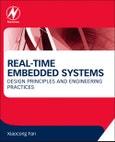This book integrates new ideas and topics from real time systems, embedded systems, and software engineering to give a complete picture of the whole process of developing software for real-time embedded applications. You will not only gain a thorough understanding of concepts related to microprocessors, interrupts, and system boot process, appreciating the importance of real-time modeling and scheduling, but you will also learn software engineering practices such as model documentation, model analysis, design patterns, and standard conformance.
This book is split into four parts to help you learn the key concept of embedded systems; Part one introduces the development process, and includes two chapters on microprocessors and interrupts---fundamental topics for software engineers; Part two is dedicated to modeling techniques for real-time systems; Part three looks at the design of software architectures and Part four covers software implementations, with a focus on POSIX-compliant operating systems.
With this book you will learn:
The pros and cons of different architectures for embedded systems
POSIX real-time extensions, and how to develop POSIX-compliant real time applications
How to use real-time UML to document system designs with timing constraints
The challenges and concepts related to cross-development
Multitasking design and inter-task communication techniques (shared memory objects, message queues, pipes, signals)
How to use kernel objects (e.g. Semaphores, Mutex, Condition variables) to address resource sharing issues in RTOS applications
The philosophy underpinning the notion of "resource manager" and how to implement a virtual file system using a resource manager
The key principles of real-time scheduling and several key algorithms
Please Note: This is an On Demand product, delivery may take up to 11 working days after payment has been received.
Table of Contents
1. Introduction to Embedded and Real-Time Systems2. Cross-Platform Development
3. Microprocessor Primer
4. Interrupts
5. Embedded System Boot Process
6. Fundamental UML Structural Modeling
7. Architecture Modeling in UML
8. Fundamental UML Behavioral Modeling
9. Modeling Stateful Behaviors in UML
10. Real-Time UML: General Resource Modeling
11. Real-Time UML: Model Analysis
12. Software Architectures for Real-Time Embedded Systems
13. POSIX and RTOS
14. Multitasking
15. Real-time Scheduling: Clock-Driven Approach
6. Real-time Scheduling: Rate-Monotonic Approach
17. Real-time Scheduling: Sporadic Server
18. Resource Sharing
19. Inter-Task Communication: Message Queue
20. Inter-Task Communication: Pipe
21. Inter-Task Communication: Signaling
22. Software Timer Management
23. QNX Resource Management








